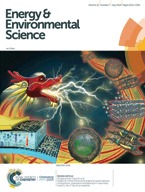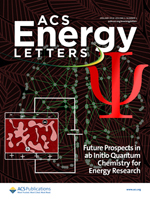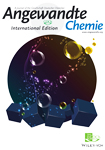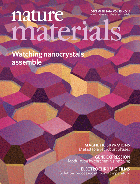ERC starting grant OMICON
Energy storage is undeniably amongst the greatest societal challenges. Batteries will be key enablers but require major progress. Battery materials that promise a step-change in energy density compared with current Li-ion batteries rely on fundamentally different reactions to store charge, e.g. Si alloying or O2 reduction instead of intercalation. They have in common high volume changes on cycling and poor conductivity. For the active component of a battery electrode to function it must be simultaneously in contact with ionic and electronic pathways to electrolyte and current collector. State-of-the-art conducting additives and binders in the composite electrodes cannot ensure ideal contact for such materials and fail to exploit their full potential.
In this project S. A. Freunberger directly targets these fundamental challenges of high-energy batteries by replacing now used conducting additives and binders with flexible organic mixed ion and electron conductors that follow volume changes to ensure at any stage intimate contact with ions and electrons. This requires progress with the fundamental science of such conductors, for which to achieve we develop and combine synthetic, electroanalytic and spectroscopic methods, aided by theory. Mixed conducting polymer gels, designed for the particular storage material, are elaborated for two ultra-high capacity electrodes, the O2 cathode and the Si anode. The significant advantage, next to intimate contact, is that the packing density of active material can be maximized. This boosts energy stored by total electrode mass and volume by rigorously cutting the amount of non-active materials compared with current approaches. The expected overriding scientific impact includes improved understanding of mixed conductors concerning synthesis, structure, conductivity and their behavior in the complex battery environment. This opens up new perspectives for the realm of high-capacity battery materials that demand such a breakthrough to succeed.
Dr. Eléonore Mourad, Dr. Christian Prehal, Yann K. Petit, Aleksej Samojlov MSC, and Christian Leypold MSc, are currently working on these topics.
Publications from OMICON
 "Singlet oxygen from cation driven superoxide disproportionation and consequences for aprotic metal-O2 batteries."
"Singlet oxygen from cation driven superoxide disproportionation and consequences for aprotic metal-O2 batteries."
Mourad, E.; Petit, Y. K.; Spezia, R.; Samojlov, A.; Summa, F. F.; Prehal, C.; Leypold, C.; Mahne, N.; Slugovc, C.; Fontaine, O.; Brutti, S.; Freunberger, S. A. Energy Environ. Sci. 2019, in press. DOI: 10.1039/C9EE01453E
 "Quantifying Total Superoxide, Peroxide and Carbonaceous Compounds in Metal-O2 Batteries and the Solid Electrolyte Interphase."
"Quantifying Total Superoxide, Peroxide and Carbonaceous Compounds in Metal-O2 Batteries and the Solid Electrolyte Interphase."
Schafzahl, B.; Mourad, E.; Schafzahl, L.; Petit, Y.; Raju, A.; Thotiyl, M.; Wilkening, M.; Slugovc, C.; Freunberger, S. A. ACS Energy Lett. 2018, 3, 170-176. DOI: 10.1021/acsenergylett.7b01111
 "Singlet Oxygen during Cycling of the Aprotic Na-O2 Battery."
"Singlet Oxygen during Cycling of the Aprotic Na-O2 Battery."
Schafzahl, L.; Mahne, N.; Schafzahl, B.; Wilkening, M.; Slugovc, C.; Borisov, S. M.; Freunberger, S. A. Angew. Chem. Int. Ed. 2017, 56, 15728-15731. DOI: 10.1002/anie.201709351 - rated as Very Important Paper (VIP)
 "Mechanism and performance of lithium–oxygen batteries – a perspective."
"Mechanism and performance of lithium–oxygen batteries – a perspective."
Mahne, N.; Fontaine, O.; Thotiyl, M. O.; Wilkening, M.; Freunberger, S. A. Chem. Sci. 2017, 8, 6716-6729. DOI: 10.1039/C7SC02519J
 "True performance metrics in beyond-intercalation batteries."
"True performance metrics in beyond-intercalation batteries."
Freunberger, S. A. Nat. Energy 2017, 2, 17091. DOI: 10.1038/nenergy.2017.91
 "Singlet oxygen generation as a major cause for parasitic reactions during cycling of aprotic lithium-oxygen batteries."
"Singlet oxygen generation as a major cause for parasitic reactions during cycling of aprotic lithium-oxygen batteries."
Mahne, N.; Schafzahl, B.; Leypold, C.; Leypold, M.; Grumm, S.; Leitgeb, A.; Strohmeier, G. A.; Wilkening, M.; Fontaine, O.; Kramer, D.; Slugovc, C.; Borisov, S. M.; Freunberger, S. A. Nat. Energy 2017, 2, 17036. DOI: 10.1038/nenergy.2017.36

"Biredox ionic liquids with solid-like redox density in the liquid state for high-energy supercapacitors."
Mourad, E.; Coustan, L.; Lannelongue, P.; Zigah, D.; Mehdi, A.; Vioux, A.; Freunberger, S. A.; Favier, F.; Fontaine, O. Nat. Mater. 2017, 16, 446-453. DOI: 10.1038/nmat4808